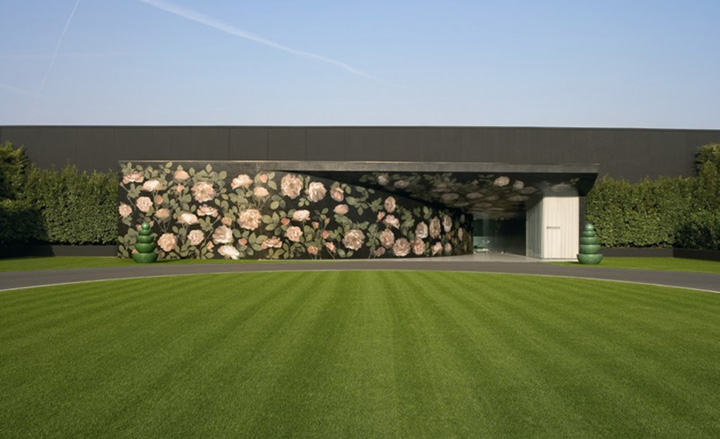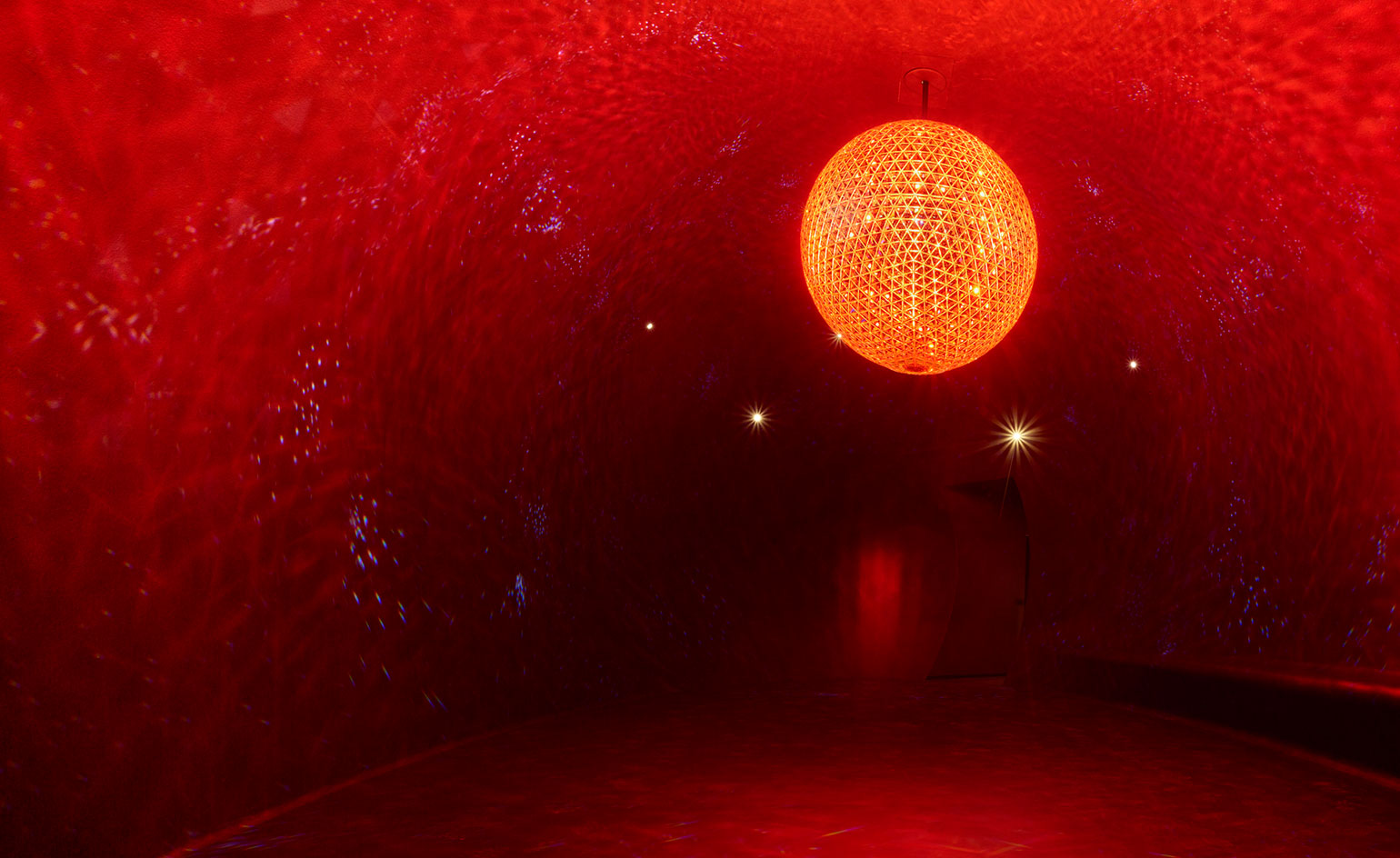Experimental Growth by Arik Levy at Fondazione Bisazza

Vicenza and its more famous neighbour Venice might remain submerged by floods this morning, but last week, the region was fortuitously blessed with good weather for the unveiling of designer Arik Levy's latest work at the Fondazione Bisazza.
Titled 'Experimental Growth', Levy's installation is an epic three-piece act that presents a futuristic vision of time and space. The exhibition centres around the impressive 'Rock Chamber', a multi-faceted single room construction, measuring a whopping 7.65-metres long and 6-metres high, covered with shimmering Bisazza tiles.
From one side, the angular site-specific structure gives the impression of a carbonized meteorite that has arrived on earth. The opposite façade reveals a hollow interior lined in chartreuse Kvadrat fabric and decorated with a FractalCloud lamp, also designed by Levy. The idea, explained the Paris-based Israeli designer, is that 'we are the prehistoric men of the future and this is our future cave.'
Despite its abstract, concept-driven nature, the installation is actually aimed at evoking a much more human reaction. Said Levy: 'What is important for me is to generate a jumping board in the experience for the people who come in. [This work] is quite in contradiction to the [other pieces] that are here already. It draws a completely new line for the Foundation's visitors. They come into a contemporary space, and there is a moment of not knowing where you are.'
The displacement aspect is another thing that Levy was allowed to express with great liberty. Adjacent to the main hall, the designer was given free reign to design and manipulate the existing physical architecture of the space within the Foundation. Levy redesigned its proportions, tinkering with walls to give them a slight curvature.
'My architectural idea was to have the walls start moving, and give the sensation that they are sliding down. It's only a hint - a sign that it's happening - and not everyone sees it but that's the beauty of it,' he said.
The new Levy Hall not only houses several miniature models of the realized Rock Chamber in the room next door, but also presents a video installation that interacts with visitors, visually changing according to the movements they make.
All three components will join the Foundation's permanent exhibition of design art works - including pieces from Alessandro Mendini, Studio Job, Jaime Hayon and Ettore Sottsass - which first went on show to the public last summer.
We caught up with Levy to discuss what made this particular collaboration so significant...
How did your pairing with Bisazza come about?
It all started about 4-5 years ago when Piero [Bisazza] acquired the piece before the foundation even existed. Before I met [Bisazza], I never had even the faintest idea about using mosaic as the skin. It was only through the discussions and the opportunities that arose that it seemed so natural, not because it was what they produced, but because my narrative talks about a meteorite from outer space. It was the perfect skin for it not to appear burnt out.
Before, it was just matt black and made out of wood. It did not have a formation that made it a unit. The gap between the facets were very visible, so you saw this Meccano puzzle that made it what it was. When you look at it now, as one single piece of almost nine metres, it actually elevates the object and makes it something with no beginning and no end. Every side is its front and every side is its back. It's 360 degrees inside out.
Was this three-pronged representation of a single idea important to you?
In the beginning it was a product installation and exhibition, but slowly, Bisazza started wanting to keep everything that was done for the exhibition. So the exhibition became permanent before it even existed somehow.
It really shows who [Bisazza] are; very Latin, very emotional, very Italian about things. Even though they run things like a swiss pharmacy, in terms of order and approach.
In terms of the story of the installation, it was important to give visitors a contrast in scale, with this giant thing that you can't really see both sides of. It looks at you instead of you looking at it, and then you go to the other space which has this gigantic height and volume, and there are these little sculptures that force you to come down and look, and you realize that it is the same, much alike but different skin.
What is your most important tool when designing?
Critical spirit. It's what I tell my students whenever I teach. You've got to have a sort of critical spirit. The biggest tool one should use is the garbage bin. You need to learn to put away things that you've done and not fall in love with everything. Not everything is good. I trash a lot. It hurts, it's painful. It's not economically logical, but this is necessary.
Is there work that you've looked back on and had second thoughts about?
When I look back, and see things that I regret, it's not an issue of aesthetics. It's more when I spot fundamental mistakes of my life principles and what I practice. Especially in the world of design. In art, it doesn't exist. You do what you do and its irrelevant if you like it or not. It's made for me. But in design, it's very relevant. So if you create a disaster, you do it industrially. You have to develop the tools to look at what you have done and self-criticism is definitely one of them.
Is this why you've made the move more towards the art world?
No, I come from art. But how do you make a life being an artist? 25 years ago, it was not what it is today. An artist didn't sell a sketch for £10,000. I chose design as a way to make a living, because of its closeness to art. Design has a very harsh reality, especially when we talk about furniture and lighting. 0.00001% of the design industry is considered the greatest. You have one out of 50 products that is doing ok, and one out of 500, which is doing fantastic. And you don't even know why.
So we can expect to see more artistic pursuits from you in the coming future?
I have a new exhibition opening in Paris on 20 November, which will showcase 30 of my art works from over the years. It discusses the relationships between full and empty, present and absent, tangible and intangible.
'Nothing is quite as it seems', a solo exhibition of Arik Levy's artworks, will run from 20 November to 13 January at Passage de Retz gallery in Paris, 9 Rue Charlot, Paris 75003; T: 33.148 04 38 99; www.passagederetz.com

The exhibition is centred around the impressive Rock Chamber, but Levy has added two other components in the mix - a structural modification of the Foundation's architecture and an interactive video installation.

The Rock Chamber is an angular, site-specific structure that gives the impression of a carbonised meteorite that has arrived on earth

The idea, explained Levy, is that 'we are the prehistoric men of the future and this is our future cave.'

The opposite façade reveals a hollow interior lined in chartreuse Kvadrat fabric

It has been decorated with a FractalCloud lamp, also designed by Levy

Arik Levy examines miniature models of the Rock Chamber in the new Levy Hall, located adjacent to the main hall. The designer was given free reign to design and manipulate the existing physical architecture of the space. Levy redesigned its proportions, tinkering with walls to give them a slight curvature

Levy demonstrates his video installation, which interacts with visitors, visually changing according to the movments that they make

The entrance to Fondazione Bisazza, which opened to the public last summer
ADDRESS
Fondazione Bisazza
Viale Milano, 56
Montechhio Maggiore
36075, Italy
Receive our daily digest of inspiration, escapism and design stories from around the world direct to your inbox.
Pei-Ru Keh is a former US Editor at Wallpaper*. Born and raised in Singapore, she has been a New Yorker since 2013. Pei-Ru held various titles at Wallpaper* between 2007 and 2023. She reports on design, tech, art, architecture, fashion, beauty and lifestyle happenings in the United States, both in print and digitally. Pei-Ru took a key role in championing diversity and representation within Wallpaper's content pillars, actively seeking out stories that reflect a wide range of perspectives. She lives in Brooklyn with her husband and two children, and is currently learning how to drive.
-
 A day in Ahmedabad – tour the Indian city’s captivating architecture
A day in Ahmedabad – tour the Indian city’s captivating architectureIndia’s Ahmedabad has a thriving architecture scene and a rich legacy; architect, writer and photographer Nipun Prabhakar shares his tips for the perfect tour
-
 You can now stay in one of Geoffrey Bawa’s most iconic urban designs
You can now stay in one of Geoffrey Bawa’s most iconic urban designsOnly true Bawa fans know about this intimate building, and it’s just opened as Colombo’s latest boutique hotel
-
 Pentagram’s identity for eVTOL brand Vertical Aerospace gives its future added lift
Pentagram’s identity for eVTOL brand Vertical Aerospace gives its future added liftAs Vertical Aerospace reveals Valo, a new air taxi for a faster, zero-emission future, the brand has turned to Pentagram to help shape its image for future customers
-
 Crystal palace: Swarovski adds dreamy new ‘chambers of wonder’ to its Austria HQ
Crystal palace: Swarovski adds dreamy new ‘chambers of wonder’ to its Austria HQ -
 Nomad brings the world’s finest design galleries to a Monaco villa
Nomad brings the world’s finest design galleries to a Monaco villa -
 Crystal set: Swarovski broadcasts 120 years of brilliance with a Kristallwelten revamp
Crystal set: Swarovski broadcasts 120 years of brilliance with a Kristallwelten revamp -
 Digital crystal: Swarovski exhibition at the Design Museum, London
Digital crystal: Swarovski exhibition at the Design Museum, London